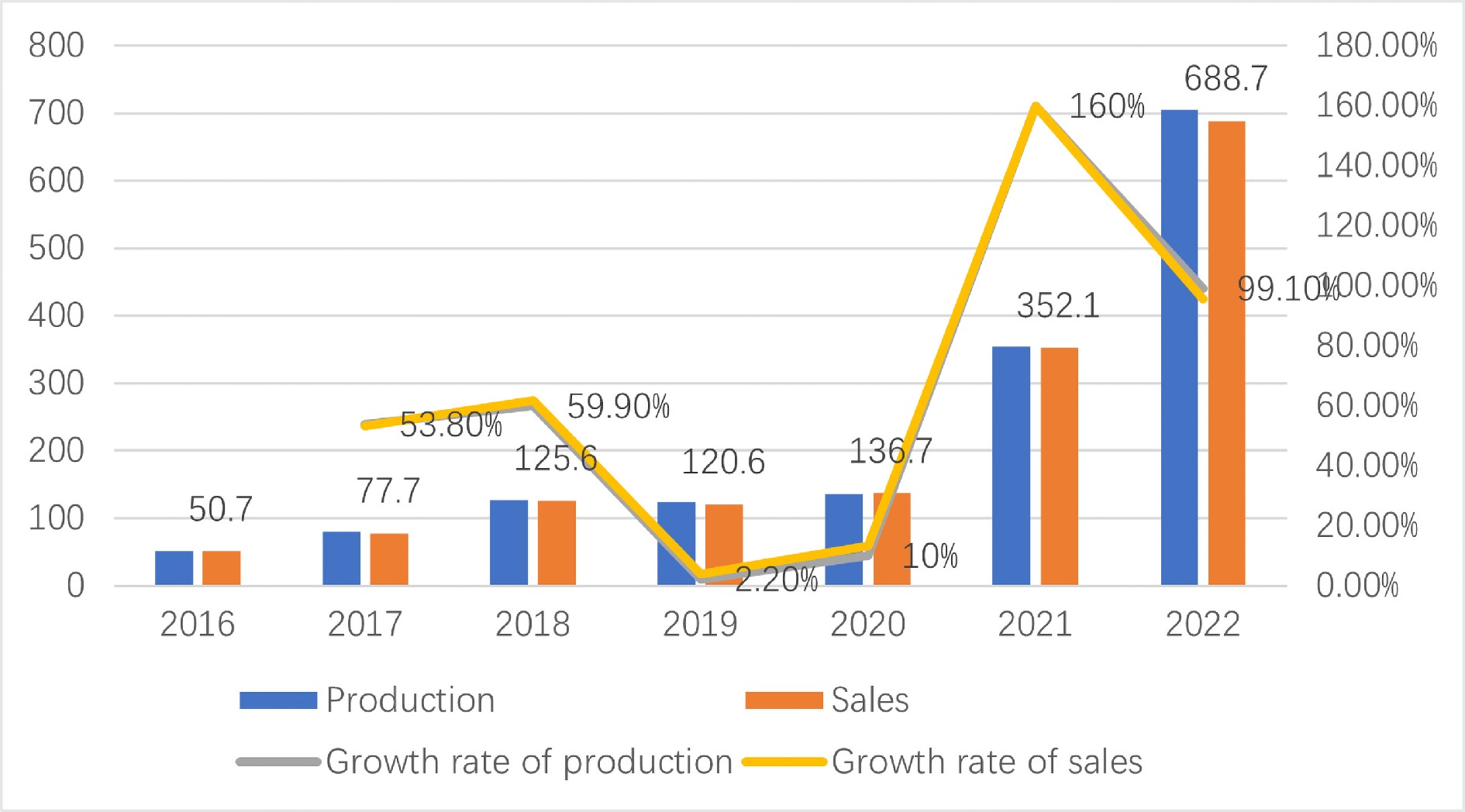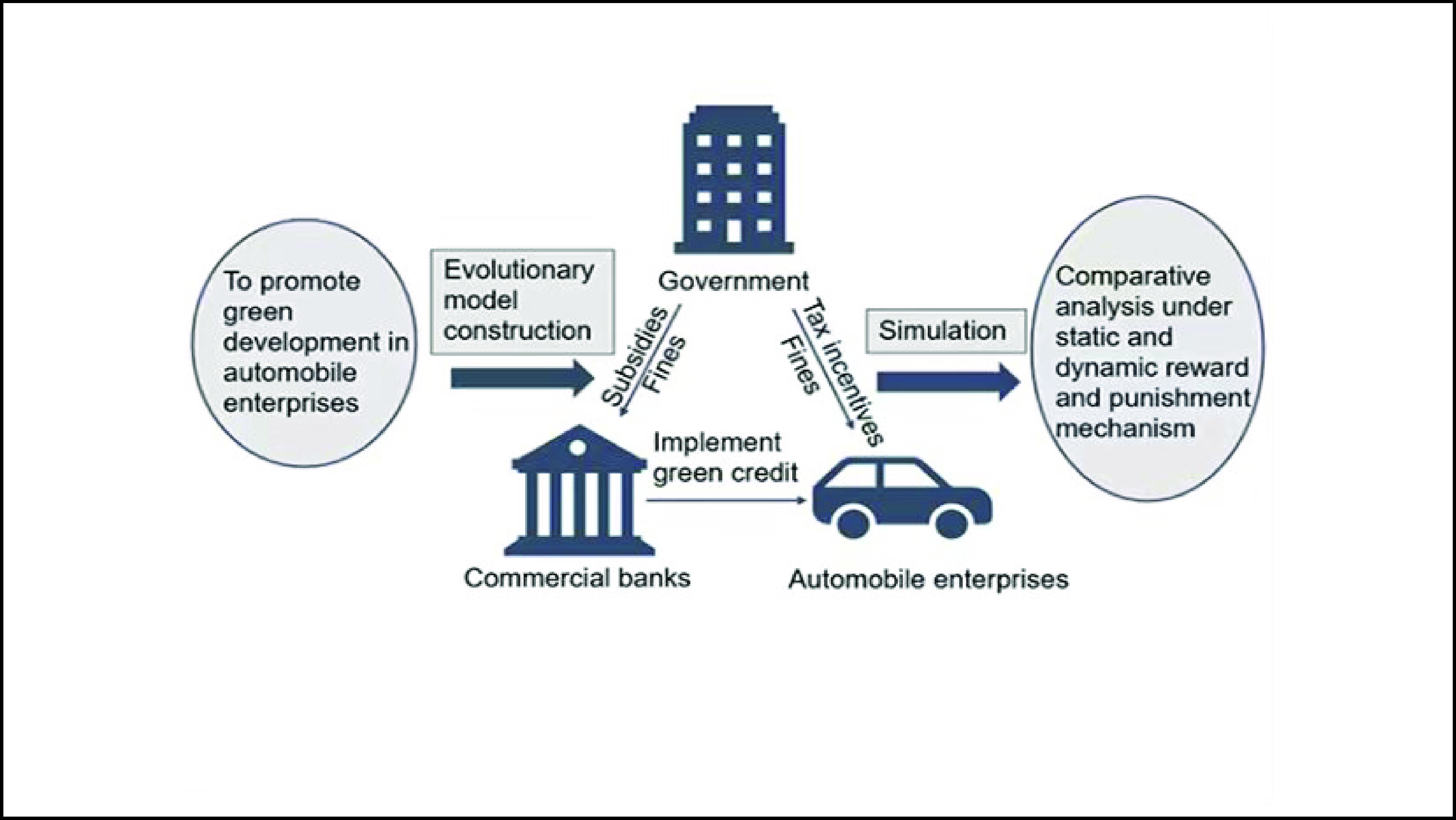
ISSN 0253-2778
CN 34-1054/N
To explore the green development of automobile enterprises and promote the achievement of the “dual carbon” target, based on the bounded rationality assumptions, this study constructed a tripartite evolutionary game model of government, commercial banks, and automobile enterprises; introduced a dynamic reward and punishment mechanism; and analyzed the development process of the three parties’ strategic behavior under the static and dynamic reward and punishment mechanism. Vensim PLE was used for numerical simulation analysis. Our results indicate that the system could not reach a stable state under the static reward and punishment mechanism. A dynamic reward and punishment mechanism can effectively improve the system stability and better fit real situations. Under the dynamic reward and punishment mechanism, an increase in the initial probabilities of the three parties can promote the system stability, and the government can implement effective supervision by adjusting the upper limit of the reward and punishment intensity. Finally, the implementation of green credit by commercial banks plays a significant role in promoting the green development of automobile enterprises.

Research methods and numerical simulation based on evolutionary model analysis.
| [1] |
Wang Y. Research on carbon dioxide emissions peaking scenario prediction and realization path in Chinese province. Scientific Decision-Making, 2022 (1): 95–105. (in Chinese) DOI: 10.3773/j.issn.1006-4885.2022.01.095
|
| [2] |
Wang Y C. Analysis on the development status of new energy vehicles in China. New Energy Technology, 2022 (11): 34–36. (in Chinese) DOI: 10.3969/j.issn.2096-8809.2022.11.014
|
| [3] |
Yu M X, Yao J. Research on the double integral policy of automobile enterprise based on game theory. Economic Research Guide, 2018 (16): 7–10. (in Chinese) DOI: 10.3969/j.issn.1673-291X.2018.16.004
|
| [4] |
Gao X Y, Chen S H, Zhang S J. Research on the support of green credit to the development of new energy enterprises in China. Research of Financial and Education, 2022, 35 (6): 11–21. (in Chinese) DOI: 10.3969/j.issn.2095-0098.2022.06.002
|
| [5] |
Xu J, Chen F J, Ma L X, et al. Tripartite evolutionary game analysis of new energy vehicle promotion policy from the perspective of prospect theory. Science and Technology Management Research, 2022, 42 (11): 66–72. (in Chinese) DOI: 10.3969/j.issn.1000-7695.2022.11.008
|
| [6] |
Fan R, Dong L. The dynamic analysis and simulation of government subsidy strategies in low-carbon diffusion considering the behavior of heterogeneous agents. Energy Policy, 2018, 117: 252–262. DOI: 10.1016/j.enpol.2017.12.003
|
| [7] |
Zhang H, Cai G X. Subsidy strategy on new-energy vehicle based on incomplete information: A case in China. Physical A: Statistical Mechanics and Its Applications, 2020, 541: 123370. DOI: 10.1016/j.physa.2019.123370
|
| [8] |
Ji F S, Zhao D, Luo J R. Evolutionary game analysis on local governments and manufacturers’ behavioral strategies: Impact of phasing out subsidies for new energy vehicles. Energy, 2019, 189: 116064. DOI: 10.1016/j.energy.2019.116064
|
| [9] |
Wang H, Yin J Y. Local industrial policy and industry innovation and development: Empirical evidence from new energy automobile industry policy text. Journal of Finance and Economics, 2021, 47 (5): 64–78. (in Chinese) DOI: 10.16538/j.cnki.jfe.20210217.301
|
| [10] |
Chi R Y, Ruan H P, Yu J. A research on the innovation incentive effect of government subsidies and market financing in the new energy vehicle industry. Science Research Management, 2021, 42 (5): 170–181. (in Chinese) DOI: 10.19571/j.cnki.1000-2995.2021.05.019
|
| [11] |
Xiong Y Q, Wang X. Policy options for NEV technology innovation incentives: ‘supportive’ or ‘threshold’ policies. China Population, Resources and Environment, 2020, 30 (11): 98–108. (in Chinese) DOI: 10.12.62/cpre.20200636
|
| [12] |
Lu C, Wang Q Q, Chen Q. The price game between different automobile manufacturers by considering fuel vehicles’ emission reduction under the double credits policy. Operations Research and Management Science, 2022, 31 (10): 98–104. (in Chinese) DOI: 10.12005/orms.2022.0325
|
| [13] |
Liu J Y, Ma Y M, Li X X. The impact of dual-credit policy on technological innovation of new energy vehicle enterprises. Studies in Science of Science, 2023, 41 (10): 1887–1896. (in Chinese) DOI: 10.16192/j.cnki.1003-2053.20221228.003
|
| [14] |
Li Y M, Zhang Q, Liu B Y, et al. Substitution effect of new-energy vehicle credit program and corporate average fuel consumption regulation for green-car subsidy. Energy, 2018, 152: 223–236. DOI: 10.1016/j.energy.2018.03.134
|
| [15] |
Jiao Y Y, Yu L K, Wang J, et al. Diffusion of new energy vehicles under incentive policies of China: Role of market characteristic. Journal of Cleaner Production, 2022, 353: 131660. DOI: 10.1016/j.jclepro.2022.131660
|
| [16] |
Ding J, Li Z F, Huang J B. Can green credit policies promote enterprise green innovation? A policy effect differentiation perspective. Journal of Financial Research, 2022 (12): 55–73. (in Chinese)
|
| [17] |
Zhang C, Chen X X, Liu D. Whether green credit can promote innovation of new energy vehicle enterprises under the de-slope policy. Friends of Accounting, 2021 (2): 15–22. (in Chinese) DOI: 10.3969/j.issn.1004-5937.2021.02.003
|
| [18] |
Shu L M, Liao J H, Xie Z. Green credit policy and green innovation of enterprises: Empirical evidence from a green industry perspective. Financial Economics Research, 2023, 38 (2): 144–160. (in Chinese)
|
| [19] |
Zhang K, Li Y C, Qi Y, et al. Can green credit policy improve environmental quality? Evidence from China. Journal of Environmental Management, 2021, 298: 113445. DOI: 10.1016/j.jenvman.2021.113445
|
| [20] |
Huang J H, Lv H L, Wang L J. Mechanism of financial development influencing regional green development: based on eco-efficiency and spatial econometrics. Geographical Research, 2014, 33 (3): 532–545. (in Chinese) DOI: 10.11821/dlyj201403012
|
| [21] |
Zhu Q F, Zheng K M, Wei Y L. There-party stochastic evolutionary game analysis of reward and punishment mechanism for green credit. Discrete Dynamics in Nature and Society, 2021, 2021: 5596015. DOI: 10.1155/2021/5596015
|
| [22] |
Feng C, Han C F, Liu P H, et al. Green credit of China’s coal power enterprises during green transform: A tripartite evolutionary game analysis. Energies, 2022, 15 (16): 5911. DOI: 10.3390/en15165911
|
| [23] |
Zhou X X, Jia M Y, Zhao X. An empirical study and evolutionary game analysis of green finance promoting enterprise green technology innovation. China Industrial Economics, 2023 (6): 43–61. (in Chinese) DOI: 10.19581/j.cnki.ciejournal.2023.06.002
|
| [24] |
Wu J M, Tang X, Sheng Y X, et al. Research on the collaborative innovation mechanism among the government, enterprises and universities in the post-subsidy era of new energy automobiles based on tripartite evolutionary game theory. Operations Research and Management Science, 2021, 30 (4): 96–102. (in Chinese) DOI: 10.12005/orms.2021.0115
|
| [25] |
Liu C Y, Dong S Y, Le C, et al. Tripartite coordinated regulation of new energy vehicles based on dynamic Bayesian game. Frontiers in Environmental Science, 2021, 9: 649008. DOI: 10.3389/fenvs.2021.649008
|
| [26] |
Ma L, Ren H W. A game research on the technology innovation of new energy automobile oriented to endurance. Soft Science, 2018, 32 (11): 73–79. (in Chinese) DOI: 10.13956/j.ss.1001-8409.2018.11.16
|
| [27] |
Friedman D. On economic applications of evolutionary game theory. Journal of Evolutionary Economics, 1998, 8 (1): 15–43. DOI: 10.1007/s001910050054
|
| [28] |
Jin T, Jiang Y L, Liu X W. Evolutionary game analysis of the impact of dynamic dual credit policy on new energy vehicles after subsidy cancellation. Applied Mathematics and Computation, 2023, 440: 127677. DOI: 10.1016/j.amc.2022.127677
|
| [29] |
He L, Sun B Z. Exploring the EPR system for power battery recycling from a supply-side perspective: An evolutionary game analysis. Waste Management, 2022, 140: 204–212. DOI: 10.1016/j.wasman.2021.11.026
|
| [30] |
Friedman D. Evolutionary games in economics. Econometrica, 1991, 59 (3): 637–666. DOI: 10.2307/2938222
|
| [31] |
Selten R. A note on evolutionarily stable strategies in asymmetric animal conflicts. Journal of Theoretical Biology, 1980, 4 (1): 93–101. DOI: 10.1016/S0022-5193(80)81038-1
|
| [32] |
Bian C, Chu Z P, Sun Z L. Policy simulation modeling environmental regulation and green credit in enterprise’s green innovation in technology: A evolutionary game analysis of government Intervention. Management Review, 2022, 34 (10): 122–133. (in Chinese) DOI: 10.14120/j.cnki.cn11-5057/f.2022.10.009
|
| [33] |
Tian Y, Govindan K, Zhu Q. A system dynamics model based on evolutionary game theory for green supply chain management diffusion among Chinese manufacturers. Journal of Cleaner Production, 2014, 80 (7): 96–105. DOI: 10.1016/j.jclepro.2014.05.076
|
| Variable | Description |
| R | Additional revenues for government in supervision |
| S1 | Government subsidies for commercial banks implementing green credit |
| S2 | Environmental tax incentives for automobile enterprises producing NEVs |
| B1 | Government supervision costs |
| B2 | Government environmental governance costs |
| E1 | Green credit revenues when automobile enterprises produce NEVs |
| E2 | Green credit revenues when automobile enterprises produce FVs |
| T | The costs of implementing green credit in commercial banks |
| π1 | Profits of automobile enterprises producing NEVs |
| π2 | Profits of automobile enterprises producing FVs |
| r1 | Profits from using green credit to produce NEVs |
| r2 | Profits from using green credit to produce FVs |
| F1 | Government fines on commercial banks |
| F1 | Government fines on automobile enterprises |
| Government | Commercial banks | Automobile enterprises | |
| NEV | FV | ||
| Supervision | Implement green credit | R−B1−S1−S2 | −B1−B2−S1+F2 |
| E1+S1−T | E2+S1−T | ||
| π1+S2+r1 | π2−F2+r2 | ||
| Do not implement green credit | R−B1−S2+F1 | −B1−B2+F2 | |
| −F1 | 0 | ||
| π1+S2 | π2−F2 | ||
| Nonsupervision | Implement green credit | 0 | −B2 |
| E1−T | E2−T | ||
| π1+r1 | π2+r2 | ||
| Do not implement green credit | 0 | −B2 | |
| 0 | 0 | ||
| π1 | π2 | ||
| Equilibrium points | Eigenvalues λ1 | Eigenvalues λ2 | Eigenvalues λ3 |
| E1(0,0,0) | −B1+F2 | E2−T | π1−π2 |
| E2(0,0,1) | R−S2−B1+F1 | E1−T | −(π1−π2) |
| E3(0,1,0) | −S1−B1+F2 | −(E2−T) | r1−r2+π1−π2 |
| E4(0,1,1) | −S1+R−S2−B1 | −(E1−T) | −(r1−r2+π1−π2) |
| E5(1,0,0) | −(−B1+F2) | S1+E2−T | S2+F2+π1−π2 |
| E6(1,0,1) | −(R−S2−B1+F1) | S1+E1+F1−T | −(S2+F2+π1−π2) |
| E7(1,1,0) | −(−S1−B1+F2) | −(S1+E2−T) | S2+F2+r1−r2+π1−π2 |
| E8(1,1,1) | −(−S1+R−S2−B1) | −(F1+S1+E1−T) | −(S2+F2+r1−r2+π1−π2) |